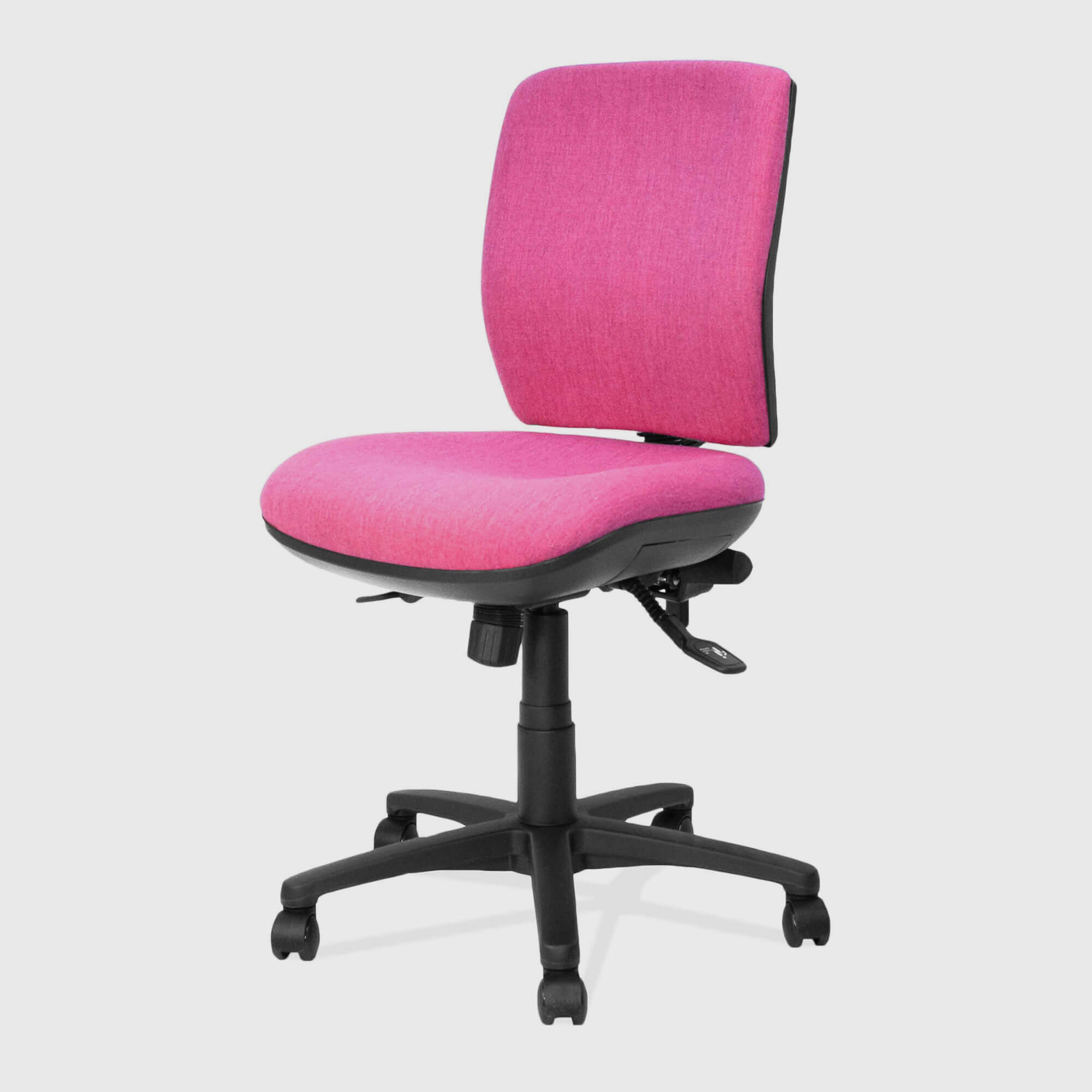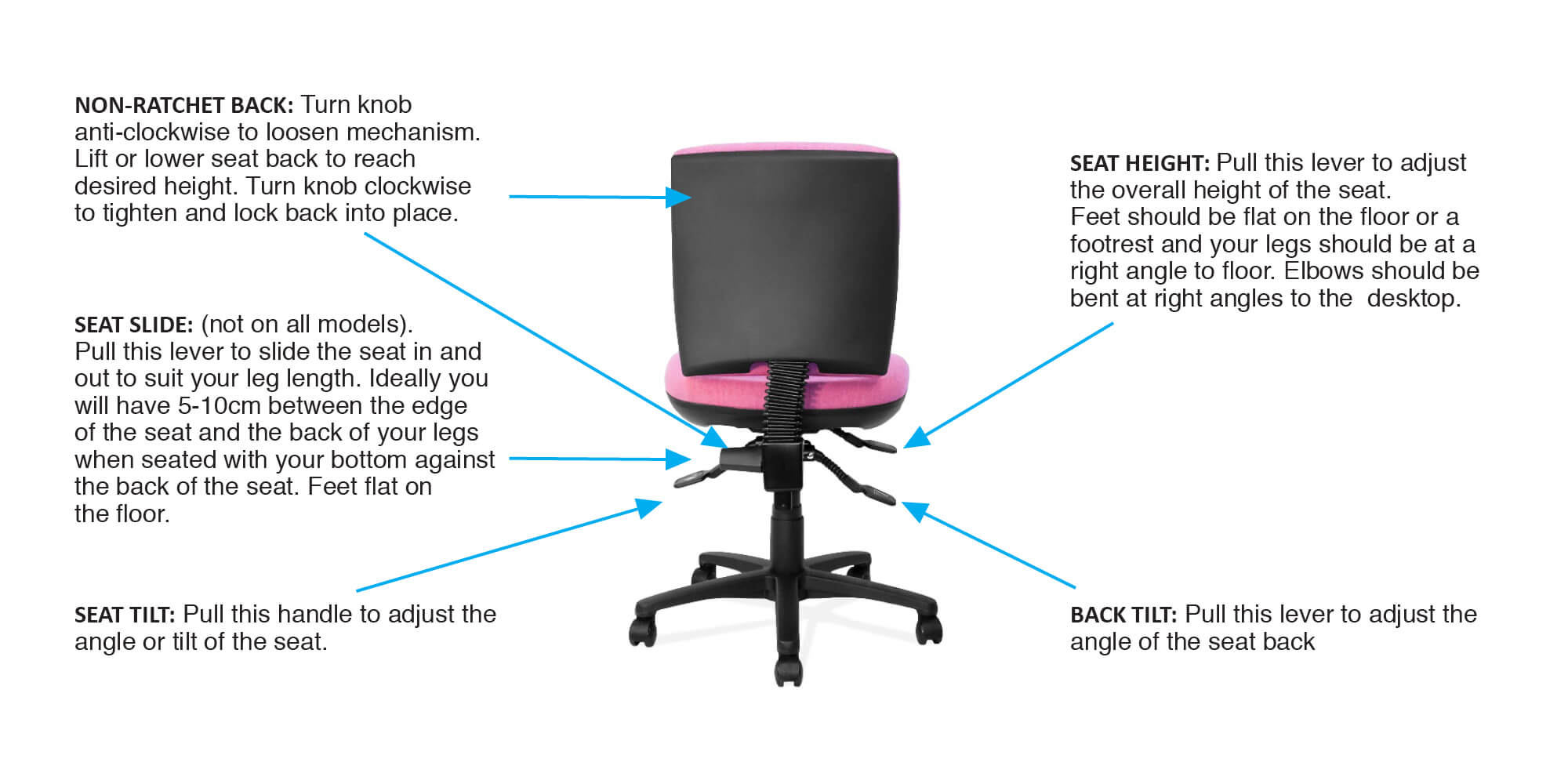Resources
TASK CHAIR – 3 LEVER MECHANISM
3 Lever Mechanism Chairs are a sound and proven ergonomic choice, especially if you use the same chair every day. You can adjust the chair to suit your individual needs throughout the day and therefore ensure the best posture for the task at hand. Below is a guide to getting the best out of your 3 Lever Mechanism Chairs. Note: not all 3 Lever Mechanism Chairs are assembled the same so this is a guide only. This is applicable for our Leo, Lyra, Magnum, Galaxy and Tik chairs.
To adjust your 3 Lever Mechanism Chair:
Subscribe for free resources and news updates.
1. Sit on chair with your bottom up against the back of the seat.
2. Height of the chair. To adjust the height of the chair, by pull on the seat height lever. This lever is often marked with an up and down icon and is on the front right-hand side of the chair.
Aim: Your feet should be flat on the floor with legs at right angles. Your arms should be at right angles to the desk top. If you are unable to place your feet firmly on the floor, you may need a footrest.
To increase the seat height, lift your weight from the seat and lift the lever. Release at desired position.
To decrease the seat height, use your body weight while sitting in the chair and lift the lever at the same time. Release lever at desired position.
Your feet should be flat on the floor with legs at right angles.
Ideally your arms should be at right angles to the desk top. If you are unable to place your feet firmly on the floor, you may need a footrest.
3. Angle of chair back. This lever is usually indicated by an icon showing back/forward back tilting, and is positioned on the right rear of the chair.
To adjust: Lift the lever and lean back or forward to adjust the angle of the backrest. Release when you have found the desired position.
Adjust this according to the task at hand – when you work at the computer an upright position is best, whereas whilst talking on the phone a more relaxed recline may be more comfortable.
4. Seat Angle. The lever for this is usually on the left of the chair.
To adjust: With one leg under the chair and the other outstretched, lift the lever and lean forward or backwards to adjust the seat to desired position. Release lever.
Tilt the chair slightly forward to bring you closer to the desk and relaxes the thighs and hips.
5. Height of chair back. Most 3-lever task chairs have one of two mechanisms to adjust the back height, a ratchet back, or a non-ratchet back.
To adjust a ratchet back: lift the seat back with both hands on either side of the back as it clicks in increments (usually 6-8 clicks), until you find your desired seat height. When it reaches the highest point, the seat resets to the lowest position.
To adjust a non-ratchet back: there will be a knob or lever at the bottom rear of the backrest. Loosen this knob to allow the back rest to be adjusted, lift or lower the back and tighten it once the desired height is achieved.
Many chairs have a protruding lumbar support built into the back of the chair. This should ideally be positioned in the curve of your lower back.
6. Lumbar support. Some chairs with built-in lumbar support allow the level of support to be adjusted, either via a pump or dial that increases the lumbar’s level of protrusion , or a sliding mechanism to adjust the position.
Adjust this so that the curve of your lower back is in contact with the back of the chair. This can help relieve lower back pain.
7. Seat Slide. This is not a standard feature on all chairs. If present, the lever is usually positioned to the front left-hand side.
To Adjust: Pull the lever/knob, plant your feet firmly on floor and shift your weight to slide the seat horizontally, forward or back to suit your leg length.
Ideally, you should have a hand’s width between the front of the seat and the back of your legs when seated and feet positioned firmly on the floor.
8. Armrest height. If your chair has arms, they are best positioned so they fit under the desk. If not, you may risk leaning forward, or sitting too far forward in your chair to reach the desk, which puts pressure on your back.
Arms can be adjusted to raise up and down, slide forward and back or twist for angle adjustment.

A few other points for consideration:
- You should always feel that your body is in an upright but comfortable and relaxed position.
- Your bottom should always be at the back of the seat.
- Ideally, your neck should feel upright with screen at eye level and your shoulders squared and relaxed.
- Arms should hang straight down by your side with elbows. bending at right angles to rest on your work surface.
- Feet should be flat on the floor (or on a foot rest) and your knees at right angles to the floor.
- Your back should have permanent contact with the chair back and the lower ‘lumber’ muscles should feel supported.
- Your pelvis should feel like it is tilted slightly forward with a comfortable one hand’s width from the front of the seat to the back of your knees.


